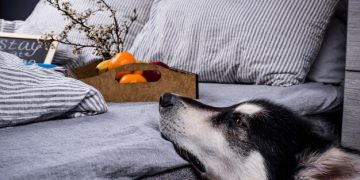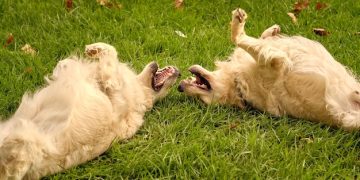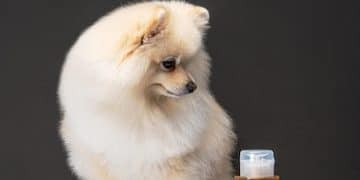Stop Excessive Licking: A 10-Day Guide to Identify & Solve the Habit
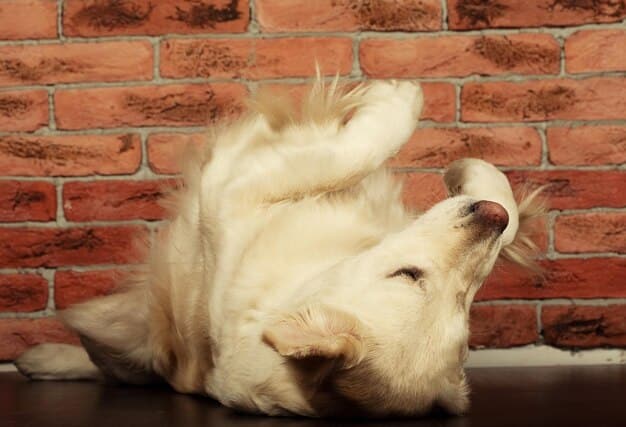
Excessive licking in dogs can stem from various underlying causes, ranging from medical issues to behavioral concerns; identifying the root cause is crucial for effectively addressing and stopping the licking habit within approximately 10 days, ensuring your dog’s well-being.
Is your dog constantly licking? It can be annoying and a sign of a bigger problem. This article, “**excessive licking: identify the cause and stop the licking habit in 10 days**,” will help you understand why and how to fix it.
Understanding Why Your Dog Licks Excessively
Excessive licking in dogs isn’t just a quirk; it’s often a symptom. Understanding the reasons behind this behavior is the first step toward helping your furry friend. From medical issues to psychological distress, there are many potential causes to consider.
Let’s explore some common reasons for excessive licking:
Medical Reasons for Licking
Sometimes, a dog’s **excessive licking** is a sign of an underlying medical condition. It’s important to rule out any health issues before assuming it’s purely behavioral.
Behavioral Reasons for Licking
Even if medical reasons are ruled out, **excessive licking** can still be a sign of distress or boredom. Addressing these behavioral causes can improve your dog’s well-being.
- Allergies: Food or environmental allergies can cause skin irritation, leading dogs to incessantly lick at the affected areas.
- Skin Issues: Dry skin, infections, or parasites can all make a dog’s skin itchy and uncomfortable.
- Pain: Dogs will often lick at an area where they are experiencing pain, whether it’s from arthritis, an injury, or another internal issue.
- Gastrointestinal Problems: Studies show that gastrointestinal issues can also manifest as excessive licking, as dogs try to soothe discomfort.
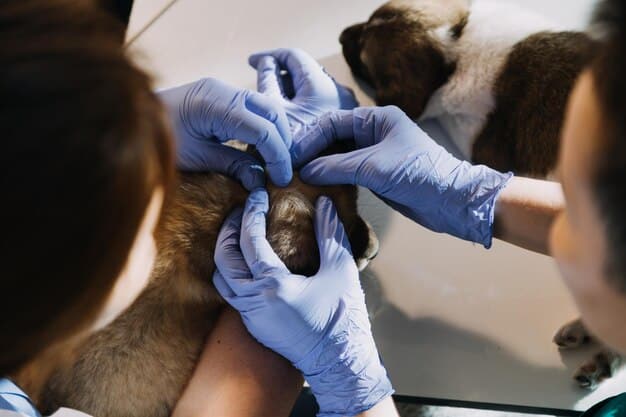
- Anxiety: Stress, fear, or separation anxiety can cause dogs to engage in compulsive licking as a coping mechanism.
- Boredom: A lack of mental and physical stimulation can lead to **excessive licking** as a way to alleviate boredom.
- Habit: Sometimes licking starts for one reason but becomes a learned behavior that the dog continues even after the initial cause is gone.
- Attention-Seeking: A dog may learn that licking gets them attention from their owners, even if it’s negative attention.
Identifying whether the **excessive licking** has a medical or behavioral root is crucial for determining the correct course of action. Always consult with a vet to rule out medical issues before addressing behavioral ones.
Step 1: Rule Out Medical Causes with a Vet Visit
Your first step in stopping your dog’s **excessive licking** should always be a visit to the veterinarian. A vet can perform a thorough examination to identify or rule out any underlying medical conditions that may be causing the behavior.
This is a critical step because if the licking is caused by a health problem, no amount of behavioral modification will solve the issue. Only treating the underlying medical condition will stop the licking.
What to Expect During the Vet Visit
During the vet visit, be prepared to provide a detailed history of your dog’s licking behavior, including when it started, how often it occurs, and any other symptoms you’ve noticed.
The vet may perform the following:
- Physical Exam: A comprehensive physical exam to look for any visible signs of skin issues, injuries, or pain.
- Blood Tests: Blood tests can help identify allergies, infections, or organ problems that could be contributing to the licking.
- Skin Scrapings: If skin issues are suspected, the vet may take skin scrapings to check for parasites, fungal infections, or bacterial infections.
- Allergy Testing: If allergies are suspected, the vet may recommend allergy testing to identify specific allergens.
Ruling out medical causes is essential before moving on to consider behavioral reasons. If your vet does identify a medical issue, follow their treatment plan carefully to resolve the underlying problem and reduce the **excessive licking**.
Step 2: Identify Triggers and Patterns of Licking
After medical causes have been ruled out, the next step is to identify what triggers your dog’s **excessive licking** and any patterns associated with the behavior. Understanding these triggers and patterns can help you develop strategies to manage and reduce the licking.
Keep a journal or make notes on your phone to track when and where the licking occurs:
Common Triggers for Licking
Identifying the triggers for **excessive licking** is essential for developing effective strategies to manage and reduce the behavior. Here are some common triggers to look out for:
- Stressful Situations: Does your dog lick more when there are loud noises, strangers around, or during thunderstorms?
- Specific Times of Day: Is there a particular time of day when the licking is more frequent, such as when you leave for work or in the evening?
- Environmental Changes: Did the licking start after a move, new pet, or change in the household routine?
Tracking the Licking Behavior
Documenting when and where the licking occurs will help you recognize patterns and potential triggers. Consider the following:
- Time and Duration: Note the time of day when the licking occurs and how long it lasts.
- Location: Where does the licking take place? Is it always in the same spot, or does it vary?
- Circumstances: What was happening just before the licking started? Were there any specific events or changes in the environment?

By identifying triggers and patterns, you can better understand why your dog is licking excessively and start to develop a plan to address the behavior. This involves both managing the environment to reduce triggers and teaching your dog alternative behaviors.
Step 3: Provide Adequate Physical and Mental Stimulation
Boredom and lack of stimulation are major contributors to **excessive licking** in dogs. Ensuring your dog gets enough physical exercise and mental engagement can significantly reduce this behavior.
A tired and mentally stimulated dog is less likely to engage in compulsive behaviors. Consider these strategies to keep your dog active and entertained:
Increasing Physical Exercise
Regular physical exercise is crucial for a dog’s overall well-being and can help alleviate boredom-related licking. Here are some ways to increase your dog’s physical activity:
Mental Stimulation Activities
Engaging your dog’s mind is just as important as physical exercise. Mental stimulation can help prevent boredom and reduce anxiety, leading to less licking.
- Daily Walks: Take your dog for regular walks, varying the route to keep them interested.
- Playtime: Engage in active play sessions with toys like balls, frisbees, or tug-of-war ropes.
- Dog Sports: Consider enrolling your dog in dog sports like agility, flyball, or disc dog to provide structured exercise and mental stimulation.
- Puzzle Toys: Use puzzle toys that require your dog to solve a problem to get a treat.
- Training Sessions: Short, regular training sessions can keep your dog mentally engaged and strengthen your bond.
- Interactive Games: Play hide-and-seek with treats or toys to stimulate your dog’s problem-solving skills.
Providing ample physical and mental stimulation can help reduce **excessive licking** by addressing the underlying issues of boredom and anxiety. Aim for a balanced routine that includes both exercise and mental challenges to keep your dog happy and healthy.
Step 4: Address Anxiety and Stress with Calming Techniques
If anxiety or stress is driving your dog’s **excessive licking**, implementing calming techniques can make a significant difference. Creating a safe and comfortable environment, along with using calming aids, can help reduce anxiety and, consequently, the licking behavior.
Here are some effective calming techniques to try:
Creating a Safe and Comfortable Environment
Ensuring your dog has a secure and comfortable place to retreat to can reduce anxiety and stress. Here are some tips to consider:
Using Calming Aids and Products
There are several calming aids and products available that can help reduce anxiety in dogs. Here are some options to explore:
- Designated Safe Space: Provide a quiet, comfortable space, such as a crate or bed, where your dog can retreat when feeling stressed.
- Comfort Items: Include familiar items like a favorite blanket or toy in their safe space.
- Consistent Routine: Maintain a consistent daily routine to provide a sense of security and predictability.
- Pheromone Diffusers: Pheromone diffusers release synthetic canine pheromones that can help create a calming environment.
- Calming Supplements: Supplements containing ingredients like L-theanine, chamomile, or melatonin can help reduce anxiety.
- Anxiety Wraps: Anxiety wraps apply gentle pressure to your dog’s body, which can have a calming effect.
By creating a safe environment and using appropriate calming aids, you can help reduce your dog’s anxiety and **excessive licking**. It’s important to be patient and consistent with these techniques to see the best results.
Step 5: Redirect Licking Behavior with Training and Distraction
Redirecting your dog’s **excessive licking** involves training them to engage in alternative behaviors and using distractions to interrupt the licking habit. This approach can help break the cycle of licking and replace it with more desirable actions.
Here are some effective strategies for redirecting licking behavior:
Teaching Alternative Behaviors
Training your dog to perform alternative behaviors when they feel the urge to lick can provide a positive outlet and replace the unwanted habit. Here are some behaviors to teach:
Using Distractions to Interrupt Licking
Distracting your dog when they start to lick can break the cycle and prevent the behavior from escalating. Here are some distraction techniques to try:
- “Leave It” Command: Train your dog to respond to the “leave it” command, which tells them to stop what they’re doing and focus on you.
- Sit or Stay: Teach your dog to sit or stay as an alternative to licking, rewarding them with praise and treats.
- Play Fetch: Engage your dog in a game of fetch to redirect their attention and energy.
- Offer a Toy: Provide a favorite toy to chew on or play with instead of licking.
- Engage in a Game: Start a quick game of tug-of-war or hide-and-seek to redirect their focus.
- Give a Treat: Offer a healthy treat to distract them from licking and reward them for stopping the behavior.
By consistently redirecting your dog’s **excessive licking**, you can help them break the habit and replace it with more appropriate behaviors. Positive reinforcement and patience are key to success. With time and consistency, your dog can learn to control their licking and engage in more desirable actions.
| Key Point | Brief Description |
|---|---|
| 🩺 Vet Check | Rule out medical causes. |
| 🗓️ Track Triggers | Identify when & where licking occurs. |
| 💪 Exercise & Mental game | Provide physical & mental activity. |
| 🧘🏻Calming aid | Support anxiety with safe place and calming products. |
Frequently Asked Questions
▼
Constant paw licking often stems from allergies, skin irritation, anxiety, or pain. Your dog may be trying to relieve itching, soothe discomfort, or cope with stress, so it’s important to see the vet to rule out a medical issue.
▼
If the licking is accompanied by redness, swelling, hair loss, or changes in behavior, it’s more likely to be a medical issue. A veterinary exam is vital to diagnose the underlying cause, ensuring accurate and quick treatment.
▼
First, rule out any medical causes, then identify triggers. Increase exercise and provide mental stimulation. Use calming aids for anxiety, and redirect licking with training and distractions. It might be helpful to check with a veterinary behaviorist.
▼
For minor skin irritation, try an oatmeal bath or applying coconut oil. However, these remedies should not replace veterinary care for underlying issues. For anxiety issues, try a compression t-shirt.
▼
Consult a vet or a certified dog trainer if the licking is sudden, severe, or accompanied by other concerning symptoms. Professional guidance ensures that both the cause and the behavior, are properly and thoroughly addressed.
Conclusion
Stopping **excessive licking** in your dog requires patience, consistency, and a multi-faceted approach. By ruling out medical causes, identifying triggers, providing adequate stimulation, addressing anxiety, and redirecting the behavior, you can help your dog break the licking habit and improve their overall well-being.
